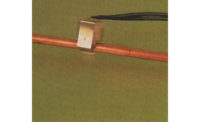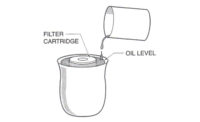Bob and Tim are looking at a system that has a frozen evaporator coil. The system is in a home. They are talking about what has happened to the system and what to do about it.
“What could be the cause of this freeze up?” Tim asked. “The whole evaporator is frozen, the suction line is frozen out to the condenser, the compressor has a block of ice on the side of it, and it is 90 degrees out here.”
“There are several things that can cause a frozen evaporator,” Bot replied. “It could be a low charge; a restricted metering device; low airflow, or a dirty filter or coil;or mild weather. Our job is to find out what the problem is and solve it.”
“Where do we start?” Tim asked.
Bob explained, “We must first thaw the system out completely and see how the system operates, then check the pressures and temperatures. We can see if we have a low charge or restricted refrigerant flow. We should check the air filter before we do anything.”
They checked the air filter and it was clean.
“We have to thaw the system out before we can examine the evaporator coil,” Bob said. “Turn the thermostat to ’off’and then turn the fan switch to the ’on' position. This will stop the compressor and leave the fan running, which is the fastest way to get the ice melted off of the coil. This will take about 30 minutes. Meanwhile, we can use this time to examine the compressor contactor, oil the outdoor fan motor, and see if the condenser coil needs cleaning.”
They did the service procedures on the outdoor unit until about 40 minutes had passed. They then went in to one of the air registers and determined that the airflow felt normal.
“The airflow feels normal, I believe the coil has thawed out,” Bob said. “Let’s examine the coil and see what it looks like.”
They removed the coil access door and examined the coil. It was clean, with no apparent obstructions. There were no signs of ice.
“The coil looks good and clear, but let’s give it five more minutes of airflow to be sure it is thawed out in the core of the coil,” Bob suggested. “The ice that builds up under these conditions has a lot of air in it. It is not solid ice, so it will melt off really quickly.”
They waited a few minutes then started the system back up so they could examine the system while it was running. They did a “touch test” at the compressor suction line and the liquid line.
“The suction line is really cold,” Bob said. “From this standpoint, I believe there is plenty of refrigerant in the evaporator. I don’t want to fasten gages to the system unless we suspect the charge is low. I make that standard practice because I can’t count the number of times I have seen technicians alter the correct charge in the name of checking the charge. I have also found incidences where a technician added gages and then left a leak where there wasn’t one before. I think that it is better practice to leave a good working system alone.”
Bob felt the liquid line and said, “The liquid line is cool— a sign that there is subcooling — which is furnishing plenty of liquid to the orifice expansion device.”
“We believe that the airflow is good, there is plenty of refrigerant in the system, and it is not mild weather, what else is happening?” Tim asked.
Bob studied for a minute and said, ““Let’s talk to the owners about how they operate the system.”
“We both work from 8 a.m. to 5 p.m. every weekday, so we turn the a/c off all day to save money,” the owner said. “We turn it on when we get home about 6 p.m. It worked well all summer.”
“Here is the problem with that type of operation,” Bob explained. “During the hot summer, we have really warm nights. It is getting into the fall, and the nights are cooling down. This type of system has an orifice metering device (Figure 1) and will not operate for long periods of time during these cool fall evenings. If you just left your thermostat at your preferred set point, the unit would be shutting down from time to time when the thermostat was satisfied. When you come home to a warm home, the unit is going to run for a long period of time causing the coil temperature to drop below freezing and condensate to freeze on the coil (Figure 2). It will continue to operate in this freezing condition, which will block more airflow until the airflow is completely blocked. Then the unit cannot satisfy the thermostat. The coil was a solid block of ice when we arrived, and the unit had been running all night. It would not thaw out during the day if left running because no warm air can reach the coil to thaw it.”
“We thought we were doing the right thing and saving energy,” the owner said. “What can we do that will work? Did we hurt the equipment?”
Bob replied, “I don’t think any damage was done, the unit is running great. If you want to use daytime temperature set back, I would suggest that you set the daytime temperature at about 5 degrees warmer than your night time setting. The system should be able to lower the space temperature 5 degrees before freezing the coil.”
As they were riding away, Tim asked, “Isn’t it hard on the unit for the coil to be frozen up like that unit was? It seems like liquid should have been slugging back to the compressor.”
“It is certainly not good for the compressor running for long periods of time like it was running with some liquid refrigerant moving into the compressor,” Bob explained. “This liquid would not slug into the compressor cylinders but would dilute the lubrication in the crank case. I think the compressor is OK.”
Publication date: 9/17/2018
Want more HVAC industry news and information? Join The NEWS on Facebook, Twitter, and LinkedIn today!






